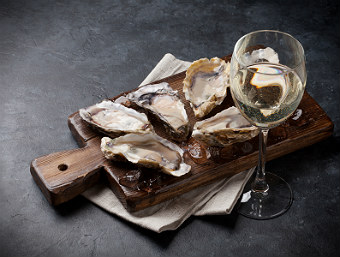Pairing Concepts
Two concepts beyond the above components also need to be understood: "Complement vs Contrast" and "My body likes your body".
Body & Body
Match body (weight, flavor intensity, complexity) of food with wine. Realize food is almost always dominant in the relationship. Food brings a texture and tactile component that wine can seldom overwhelm. It can help and hinder, but food tends to dominate. Don't expect wine to rescue a badly executed dish, unless you've gotten the guest drunk before it arrives. It's very rare that body of wine and body in food work well in opposition to each other. You may say Champagne with XXX, but that's not really fair as Champagne/Cava can go with about anything due to its light body and high acid. We've had a Hatch green chili and chipotle rubbed ribeye that was fine with a Brut Cava.
Complement vs Contrast
Wine has similar components to food. Both have body (or weight); there is acid and sweetness; there is tannin/bitterness; there is texture. Matching components together results in a complementing pairing which tends to accentuate that particular component. Contrasts can blend or harmonize components. Similar to the way musical notes at very different octaves can be more enjoyable to the ear than the note by itself.
The perfect example of these two concepts at work is the classic Tawny Port and Blue Cheese pairing. Both have intense body, there's nothing that hits your palate quite like either of them. Take a big mouthful of either one by itself if you don't agree! But they have very different flavors, there is a salty pungency to blue cheese and a rich sweetness to Port. This contrasting bitter and sweet brings the Port's sweetness down a notch while also softening the blue cheese's salty bitterness. They are both better for the contrast, but it also works because the body is in harmony.
The idea of pairing to the protein is a common fallacy as many proteins vary considerably in texture/body depending on cooking technique, or even given different cuts of the same protein. Find which aspect of the dish is most prevalent or distinctive as the anchor to pair to. It might be the sauce, it might be the cooking technique, it might be spices that are leading the show with the protein acting like the delivery vehicle.
Regarding salad courses, yes you want to tell your guests that salad is a palate break and not a course to pair to but they are always right. We've seen good quality (Kremstal, Wachau) Gruner Veltliner and dry sparkling stand up to salad with vinegar based dressings. Often the best that can be done is to minimize disruption on the palate, a complementary pairing is generally out of reach.

A great pairing is dry sparkling and fried chicken (or popcorn). This pair is all about a neutral protein with both fat and texture in the coating where the acid in the bubbly eats through the fat, and the tactile mouthfeel of the bubbly plays nice with the crunchiness. Embrace the concept that a successful pairing may be primarily textural or tactile rather than flavor based.
Another classic pairing is Muscadet with oysters on the half shell. As almost everyone adds acid to oysters (in the form of lemon juice) why not use a much tastier acid? This pairing is almost more about the salty sea brine than the actual oyster. The salt softens the austere acidity of the Muscadet and lets just a little sweetness lighten up the very subtle oyster flavors.
Some of the worst pairings are the "regional" pairings gone awry. Most pairing articles and books out there will tell you if it "grows together, it goes together..." As Americans, we don't have the sense of history or geography to know that tomatoes were not historically grown in Tuscany or in Piedmont. Fresh, herby tomato sauce and a young Barolo or Chianti is one of the worst pairings you can attempt. Acid elevating acid and depressing the subtle fruit turns the wine into water and mutes the bright herbal components designed to be lifted by the tomato. Try it, make front and back of house taste pairings too.
- What is a sommelier
- Why to certify
- Prerequisites and Testing Criteria
- Wine List Creation
- Wine List Training
- Storage and Service Temperatures
- Introduction to Pairing and Components
- Pairing Concepts
- Service Intro and Presentation
- Service Opening the Bottle
- Sample and Pouring Order
- Sommelier Standards Sparkling Wine
- Sommelier Standards Beer Service
- Sommelier Certification Registration